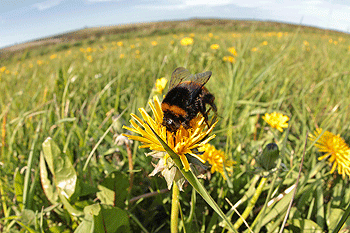The plight of the bumblebee

Gamekeepers within the shooting community are often seen as the custodians of our countryside, but more people need to become aware of this. Keepers look after varying habitats including upland, lowland, heathland and woodland, as well as streams, rivers, lakes and ponds. In fact, you could say that much of the UK’s wildlife relies on the gamekeeper, stalker or gillie to a certain extent.
Many people think that keepers are driven to nature conservation solely to provide a habitat for gamebirds and mammals such as deer and hare. But, in the main, that is untrue. The keepers I know (and I probably know more than most because of my role with the National Gamekeepers’ Organisation) are true country people and have a genuine love of the countryside and the natural environment they work in. Most of us can only dream of an office with thousands of acres that we can watch develop as the seasons progress and give it, and the animals that live in it, a helping hand to thrive.
One species that unfortunately is declining in the UK is the humble bumblebee. We have all seen these bees with their distinctive ungainly flight, supping nectar from blossoms and flowers. But this common sight might become a thing of the past in a relatively short time. In the UK, two species of bumblebee have become extinct in the past 80 years and there are currently 24 species in existence, many of which are rare or very rare.
As shooters, there is a lot we can do to help halt the decline of the bumblebee by introducing some fairly simple environmental factors that will produce the flowers that bees need to survive.
This includes hedgerow management and using the pollen and nectar mixes in some of our wild bird options on the shoot. Creating rides in woodland and planting them with wild flowers is also an excellent idea to help bees and it isn’t too bad for ground-nesting birds, either. Gamekeepers can also grow gamecover crops that are insect-rich using mixtures that contain sunflowers, phacelia and borage, as well as the more traditional covers. All of this can be achieved via the Entry Level Stewardship and Higher Level Stewardship schemes.
The most important time for the bumblebee is between March and September, a similar time that keepers are looking for cover for nesting birds and places for broods to hide. So preventing the plight of the bee fits nicely with our other work.
Badger threat
Bumblebees have another problem — they are hunted by one of the UK’s largest predators, the badger. We have all seen bumblebee nests dug up overnight by badgers, which must be having some effect on a bee population that is already under pressure — though research that will confirm or deny the badgers’ impact is thin on the ground.
When you find a bumblebee nest in the ground, you can create some defences around it to help stop the badgers digging up these precious nests. The defences are simple but effective and can be made from any material that you happen to have to hand. When I was riverkeeping in Hampshire I often made such defences out of corrugated tin or 45-gallon drums cut down to fit (usually old feed hoppers).








